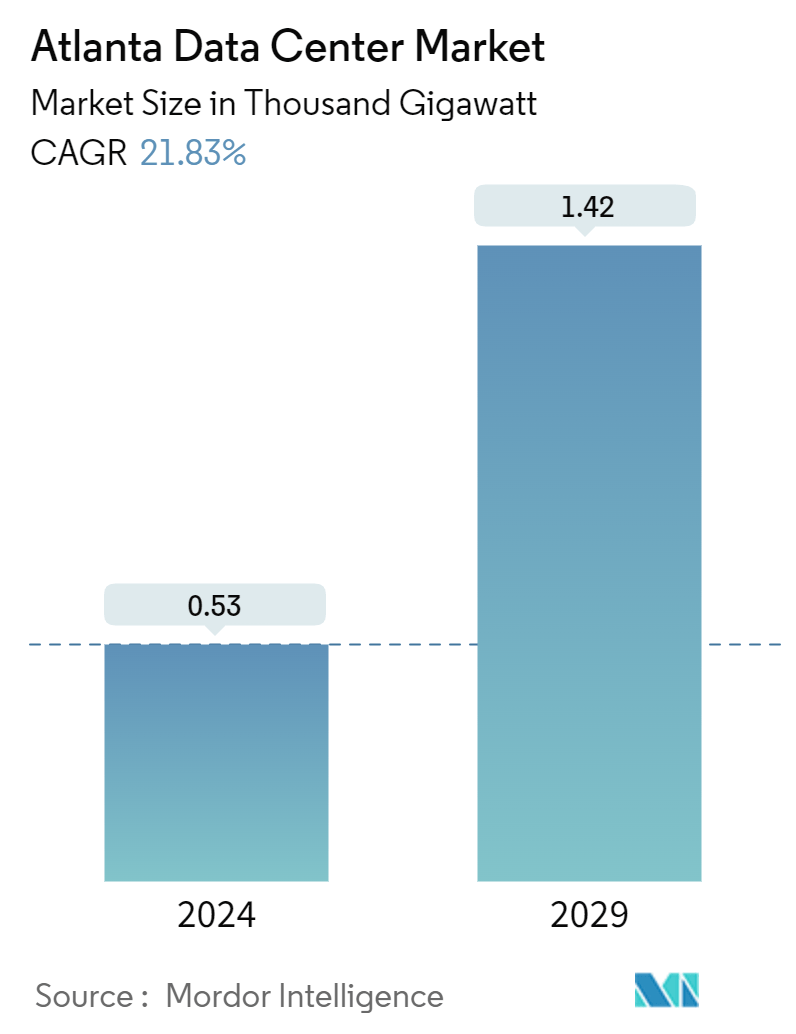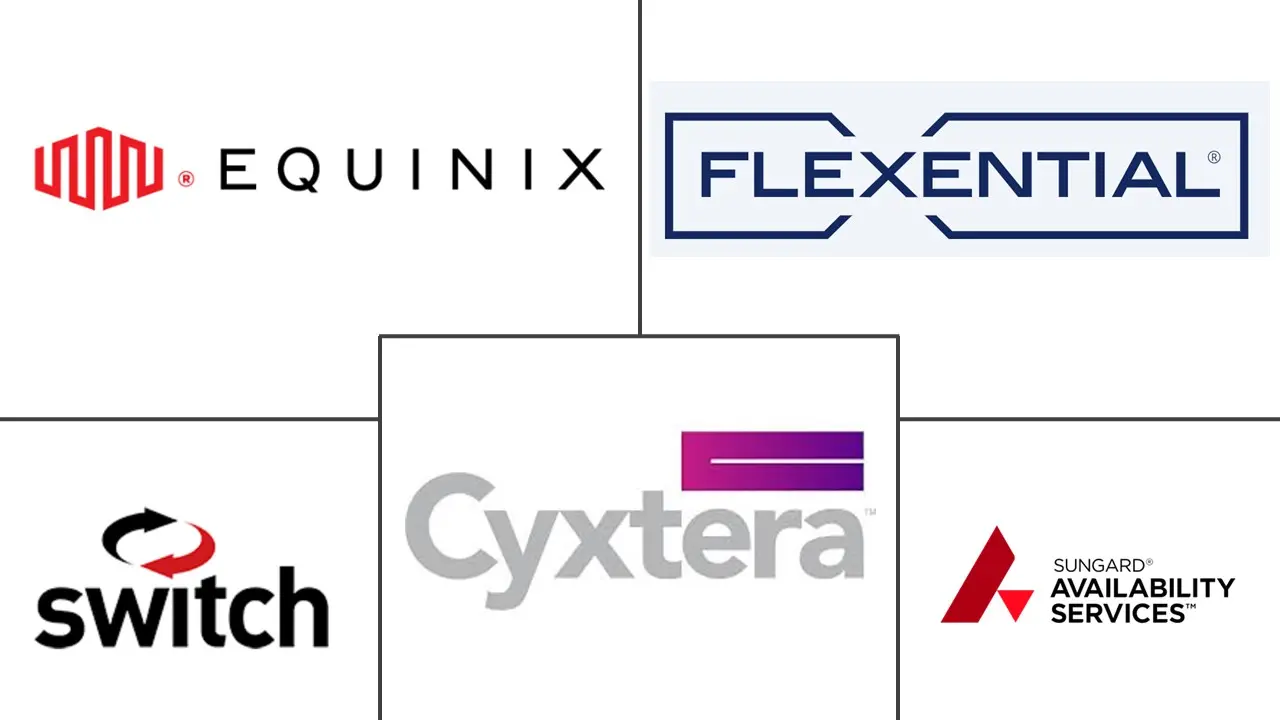Market Size of Atlanta Data Center Industry

| Study Period | 2019 - 2029 |
| Base Year For Estimation | 2023 |
| Market Volume (2024) | 0.53 Thousand gigawatt |
| Market Volume (2029) | 1.42 Thousand gigawatt |
| CAGR (2024 - 2029) | 21.83 % |
| Market Concentration | Medium |
Major Players
*Disclaimer: Major Players sorted in no particular order |
Atlanta Data Center Market Analysis
The Atlanta Data Center Market size is estimated at 0.53 Thousand gigawatt in 2024, and is expected to reach 1.42 Thousand gigawatt by 2029, growing at a CAGR of 21.83% during the forecast period (2024-2029).
The main drivers anticipated to drive the market expansion are the increasing demand for energy-efficient data centers, considerable investment by colocation service and managed service providers, and expanding hyperscale data center building. Additionally, the development of big data, cloud computing, and the Internet of Things (IoT) has made it possible for businesses to invest in new data centers to preserve business continuity. Additionally, industrial development is expected to prosper due to the rising need for security, operational efficiency, improved mobility, and bandwidth. Software-based data centers boost industry growth by providing a higher level of automation.
- Artificial intelligence (AI) with machine learning (ML) necessitates the development of brand-new data center infrastructure more than any other application. Artificial intelligence (AI) and machine learning (ML) may require three times the power density of traditional data processing, necessitating a revolution in data center architecture. This is also dependent on sophisticated cooling systems to support the larger output. The intense nature of AI and ML computations may also result in a significant dispersion of computational, memory, and storage resources among many processors in a computational cluster.
- A data center must adhere to the following specification as a Tier III facility. The facility should offer N+1 (the amount required for operation plus a backup) fault tolerance. Also, the Tier III facility providers can undergo routine maintenance without a hiccup in the overall operations. However, unplanned maintenance and emergencies may cause problems affecting the system. These problems could affect customer-facing operations.
- These data center facilities provide a 99.982% uptime. The companies using these Tier III facilities are often growing companies or businesses that are considerably larger than the average SMBs (Small to Medium Businesses). These Tier III facilities also offer most of the features of a Tier IV infrastructure facility without some elite protection. For instance, enterprises can leverage the advantage of dual power sources and redundant cooling as the network streams are fully backed up.
- The BFSI industry has been one of the most influenced by enterprises' digital transformation, allowing for more cost-effective revenues. The rising Paris adoption of mobile phones and high-speed internet has pushed individuals to choose digital banking, which has also integrated robust CRM and cloud technologies to store and analyze data, which is projected to boost market growth.The rapid expansion of electronic banking, digital storage, and virtualization in the BFSI sector will likely drive demand for cost-effective and energy-efficient data center solutions. It enables the consistent and reliable availability of IT and digital banking services in a highly protected environment. It can also connect and encrypt all device communications while controlling user access to protect against errors and bad intent.
- On the flip side, the country's commercial real estate has been constantly evolving and changing due to the continued integration of technology at all levels of the industry and across all property types. As more companies have been transitioning toward cloud computing with major vendors expanding their capacities has been influencing land prices; for instance, Amazon Web Services (AWS) currently has cloud infrastructure in 22 regions and has predicted that new data centers may be needed in hundreds of regions to keep up with demand.
Atlanta Data Center Industry Segmentation
A data center is a physical room, building, or facility that holds IT infrastructure used to construct, run, and provide applications and services and store and manage the data connected with those applications and services.
The Atlanta data center market is segmented by DC size (small, medium, large, massive, mega), tier type (tier 1&2, tier 3, tier 4), by absorption (utilized [colocation type [retail, wholesale, hyperscale], end user [cloud & IT, telecom, media & entertainment, government, BFSI, manufacturing, e-commerce]], non-utilized). The market sizes and forecasts are provided in terms of volume (MW) for all the above segments.
| DC Size | |
| Small | |
| Medium | |
| Large | |
| Massive | |
| Mega |
| Tier Type | |
| Tier 1 & 2 | |
| Tier 3 | |
| Tier 4 |
| Absorption | |||||||||||||||||
| |||||||||||||||||
| Non-Utilized |
Atlanta Data Center Market Size Summary
The Atlanta Data Center market is poised for significant growth, driven by the increasing demand for energy-efficient solutions and substantial investments from colocation and managed service providers. The expansion of hyperscale data centers, alongside advancements in big data, cloud computing, and the Internet of Things, has facilitated the establishment of new data centers, ensuring business continuity. The rise of artificial intelligence and machine learning further necessitates the development of robust data center infrastructure, requiring enhanced power density and sophisticated cooling systems. These facilities, particularly Tier III data centers, offer high uptime and are crucial for industries like BFSI, which are undergoing digital transformation to enhance operational efficiency and security.
Mega and hyperscale data centers play a vital role in supporting various applications, including IT services, healthcare, and e-commerce, by providing scalable and reliable infrastructure. The Atlanta region hosts several prominent data centers operated by companies like QTS Realty Trust, Digital Realty, and Equinix, which adhere to strict regulatory standards set by organizations such as the Telecommunications Industry Association and the Uptime Institute. The retail colocation market is also experiencing growth, driven by the demand for cost-effective and flexible solutions, particularly from SMEs. Recent developments in the market, including new constructions and strategic partnerships, highlight the ongoing evolution and consolidation within the Atlanta Data Center landscape.
Atlanta Data Center Market Market Size - Table of Contents
-
1. MARKET SEGMENTATION
-
1.1 DC Size
-
1.1.1 Small
-
1.1.2 Medium
-
1.1.3 Large
-
1.1.4 Massive
-
1.1.5 Mega
-
-
1.2 Tier Type
-
1.2.1 Tier 1 & 2
-
1.2.2 Tier 3
-
1.2.3 Tier 4
-
-
1.3 Absorption
-
1.3.1 Utilized
-
1.3.1.1 Colocation Type
-
1.3.1.1.1 Retail
-
1.3.1.1.2 Wholesale
-
1.3.1.1.3 Hyperscale
-
-
1.3.1.2 End User
-
1.3.1.2.1 Cloud & IT
-
1.3.1.2.2 Telecom
-
1.3.1.2.3 Media & Entertainment
-
1.3.1.2.4 Government
-
1.3.1.2.5 BFSI
-
1.3.1.2.6 Manufacturing
-
1.3.1.2.7 E-Commerce
-
1.3.1.2.8 Other End User
-
-
-
1.3.2 Non-Utilized
-
-
Atlanta Data Center Market Market Size FAQs
How big is the Atlanta Data Center Market?
The Atlanta Data Center Market size is expected to reach 0.53 thousand gigawatt in 2024 and grow at a CAGR of 21.83% to reach 1.42 thousand gigawatt by 2029.
What is the current Atlanta Data Center Market size?
In 2024, the Atlanta Data Center Market size is expected to reach 0.53 thousand gigawatt.

